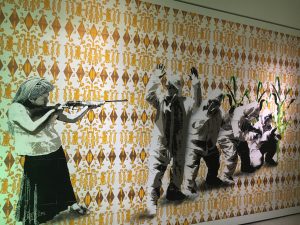In my ASTU class we studied the graphic memoir “Persepolis” written by Marjane Satrapi. She illustrates the memories of her childhood using a comic book style. As an only child, she grew up witnessing the Islamic Revolution and the fundamental change of her society. Her parents, middle-class committed Marxist, were actively involved in movements against the oppression of the Shah. Their “modern” outlook on life is clearly reflected in Marji herself. She grows up to become a rebellious teenager with ideas and impressions of her own. On the one side, Satrapi does not hesitate to show how bold and confident she already has been as a ten year old with mentioning for example her believe that she was born to be the next prophet. Neither does she hide how Marji not only lost her naive perception of the world while growing up but also changed her attitude towards religion, especially how crucial events like the execution of her loved uncle Anoosh not only opened her eyes and brought the political reality of her country closer but also caused her connection to God to fade away and be replaced by a modernist and atheist thinking. On the other hand, the image Satrapi produces of her younger self, is an intelligent young woman which now is the source of the reader’s knowledge about the highly sensitive political and religious situation during the Iran during the 1980’s. As we were driven to do after reading Rigoberta Menchu’s testimony (1994), I want to question the level of authority and truth we can give Satrapi and how much she is allowed to claim.
Every story that is being told is being told from a unique perspective. Satrapi tells the story of a child based on her memory, as it seems. It is commonly known that memory is not untouchable, unchangeable. This raised the question for me of reliability. Memories can not be told as facts, often their are unproven and subjective. Therefore, they are lacking a certain level of reliability. In Persepolis, Satrapi tells two stories. A political and a social one. The latter one cannot be proven but as I identify it, it’s main purpose is to be an assistance for the reader to put oneself into her perspective which would rather add reliability than take it. It makes us realise that the truth she is telling is personal truth, not factual truth. The political story, in contrast, cannot not be based on facts but observation and experience. It might be that Satrapi’s memories have been influenced by different stories over time, but her main aim is to tell the stories based on her experience. As long as one keeps that in mind, Satrapi has full authority to reflect on the happenings occurring during her childhood. Furthermore, one could argue that Satrapi enforces a picture onto the reader by choosing to depict her story and memories as a graphic memoir. She takes a risk with this kind a representation but also enables to represent her memory from two kinds of perspective, from Marji the experiencing protagonist in form of the speech bubbles and from the narrating Marjane as the adult voice shown in the panels.
Satrapi not only introduces the readers to the Iranian political and social situation during the 1990’s but in closer analyses Persepolis is a perfect example to make us question the credibility of the knowledge we gain from cultural artefacts. How close are personal and cultural memory connected? As Satrapi shows, often both are one and the same.
